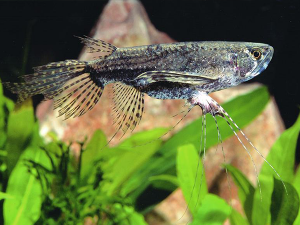African butterflyfish belong to the Pantodontidae family occupying the water bodies of West Africa. Their large colorful pectoral fins, that they wiggle when gliding in the water, makes them strikingly similar to a butterfly hence their name.

| Scientific Name | Pantodon buchholzi |
| Other Names | Freshwater butterflyfish |
| Origin | Lake Chad, Congo Basin, Cameroon, Lower Niger, upper Zambezi, and Ogooue |
| Type | Freshwater |
| Conservation Status | Least Concern (by the IUCN) |
| Behavioral Characteristics | Peaceful and cooperative when they get to dwell in their desired territory (top of the tank) uninterrupted but could get aggressive in defending their domain if other top-dwellers are coexisting with them |
| School Size | 3 -4 (prefers to live with bottom-dwelling fish) |
| Physical Traits | Small-sized, flat head, and body; upturned mouth with sharp teeth; big, pectoral fins; fan-shaped ventral fins resembling thread-like projections; large anal fins and broad caudal fins helping it to propel out of the water with ease |
| Colors | Light brown or greenish body with silvery of brownish-green fins and dark markings along the edges of the fins and undersides |
| Size | 5 inches (12.7 cm) |
| Lifespan | 5 – 6 years |
| Sexual Dimorphism | Present; Males are slimmer and have one of their anal fins’ rays to be a little longer than the remaining ones; females are heavier with a straight, flat, and uniformly arranged anal fin |
| Probable Diseases | Bacterial and fungal infections |
| Approximate Price | $15 – 20 |
| Care Level | Intermediate |
| Tank Size | 30 – 40 gallons (114 – 151 liters) |
Water Parameters
| pH Level | 6.5 – 7.0 |
| Temperature | 77 to 82° F |
| Hardness | 8 – 12 dGH |
| Aquarium Water Flow | Slow |
Tank Ambience
| Lighting | Low, subdued |
| Substrate Type | Sand, gravel, rocks, driftwood, live plants |
| Tank Mates | Compatible with: Fish that are bigger or of a similar size to them, mostly dwelling at the middle or bottom are their most suitable tank mates like bigger barb (particularly those that do not nip fins) and tetra fish, dwarf gourami, African species like African knife fish, Congo tetra, West African cichlid, catfish and elephantfish species; other African butterflyfish, mostly male-female combination Incompatible with: Dalmatian mollies, tiger barbs, and angelfish (since they are fin-nippers and could target the African butterflyfish’s long, flowing fins); any fish that are small enough to get into their mouths should also not be housed with them |
| Suitable Position in the Tank | Top |
Feeding
| Diet | Floating foods like pellets and sticks, flaky foods, small prawns, brine shrimps, alongside a whole lot of canned or live insects like flies, and crickets |
| Frequency | 2 – 3 times a day |
The African Butterflyfish is known for its hunting ability. Their alert eyes help them keep track of their prey, while their upturned mouth is designed to help these fish capture smaller preys the moment they are spotted on the water surface. Their enlarged pectoral muscles also help them in wiggling their pectoral fins as they glide along.